Just in its infancy, the drone industry is worth about $13 billion globally but expected to grow at a blistering pace in the coming years. By starting a drone business now, you could get ahead of the wave and ride it to prosperity.
To help you get started, this guide will walk you through all the steps you should take to develop your drone business idea and get it up and running, from learning about the industry to making solid money.
Read on to learn how to become the next great drone entrepreneur!
Step 1: Decide if the Business Is Right for You
Since the commercial drone industry is only a handful of years old, analyzing and understanding the market is essential. First, let’s see what types of drone business opportunities are out there.
Pros and cons
When analyzing an opportunity’s viability, it’s important to note both the positives and the negatives.
Here are some factors to be aware of in the drone industry:
Pros
- Exponential industry growth
- Straightforward certification process
- Be your own boss, choose your niche
Cons
- Privacy issues
- Potential for strict regulations
- Risk of misuse by bad actors
Drone industry trends
The global commercial drone industry is poised for a strong growth and expected to expand further into segments such as delivery, agriculture, security, construction and real estate, mining, mapping, imaging, filmmaking and more. The general trend is growth and opportunity!
Industry size and growth
Trends and challenges
These are some of the trends shaping the drone industry:
- Increasing use of drones for business purposes in several industries
- Drone are also used for crop and livestock monitoring, irrigation management, and fertilization
- Rise of open-source drones
Some challenges faced by the industry include:
- Compliance issues
- Easy target for hijacking
- Identification system for drones and their operators
How much does it cost to start a drone business?
If you start a drone business from home in a niche like photography, you could launch with as little as $8,000, or even less if you’re able to negotiate monthly payments for your insurance.
For someone looking to go all out in an advanced niche such as agriculture, you should expect to spend $100,000 or more. This estimate covers multiple advanced drones and the first month’s rent and wages for two employees.
On average, though, you should be prepared to spend $30,000 to start your drone business, with a basic office, one full-time employee, and two mid-range drones.
| Start-up Costs | Ballpark Range | Average |
| Setting up a business name and corporation | $150 - $200 | 175 |
| Business licenses and permits | $100 - $300 | 200 |
| Business cards and brochures | $200 - $300 | 250 |
| Drone | $1,000 - $20,000 | $10,500 |
| Software, supplies, and equipment | $1,000 - $4,000 | $2,500 |
| Training and certifications | $300 - $2,500 | $1,400 |
| Insurance | $100 - $300 | 200 |
| Website setup | $1,000 - $3,000 | 2000 |
| Total | $3,850 - $30,600 | $19,725 |
How much can you earn from a drone business?
Naturally, a drone software company will have very different rates from a drone piloting company. So let’s break down an example from a pilot business.
Standard services for drone pilots are inspections, photography, and thermal imaging. How much you earn from your drone business will be determined by the sector you serve and how busy you are.
While most UAV pilots charge per project, the hourly rate equivalent is around $150 for real estate or $200 for oil & gas.
In your first year or two, you could work from home and generate 15 billable hours a week at an average of $150 per hour. This would mean $117,000 in annual revenue and more than $58,000 in profit, assuming a 50% margin. As your brand gains recognition, your billable hours could double to 30 a week. At this stage, you’d rent a commercial space and hire staff, reducing your profit margin to around 35%. With annual revenue of $230,000, you’d make a tidy profit of $82,000.
What barriers to entry are there?
Before you jump into the drone business, some barriers can make entry difficult. While they aren’t impossible to pass, it’s good to be aware of them.
- FAA Remote Pilot Certificate
- Local and state drone laws
The first step to starting your drone business is to be FAA certified. You’ll need to pass the Part 107 test with a score of at least 70% to become a commercial drone pilot. The regulatory laws will depend on where you live, so make sure to research your local laws to determine whether starting a drone business is viable.
If you want to target large organizations with your skills, you’ll likely need experience. Pilot projects, for example, may require a certain number of flight hours or a safety record before a company may consider hiring you.
Related Business Ideas
If you’re still not sure whether this business idea is the right choice for you, here are some related business opportunities to help you on your path to entrepreneurial success.
Step 2: Hone Your Idea
Now that you know all about the industry, it’s time to start thinking about the finer details of your business. First, we’ll start with choosing a niche.
Why? Identify an opportunity
Your competition is any business that targets the same market as you. Before you start your own business, it’s always a good idea to learn from those that have found some success in the industry.
Take some time to search for drone businesses in your niche and see what they have to offer, in terms of services and prices. Here are some questions you can ask yourself during the research process:
- Are they meeting customer expectations?
- Have they priced their services reasonably?
- What is their unique value proposition?
- Are they using the latest technology?
- Is there an in-demand service they don’t provide?
What? Determine your products or services
There are many niches that you can choose from as a drone business owner. Your niche will be the industry you specialize in and the service you provide. Start by determining the service you will provide. Here are your choices:
- Drone piloting means you can do anything from filmmaking to precision agriculture and geographical mapping. Starting a drone photography business is the most common option when it comes to capturing aerial footage.
- Drone repair services are in demand as the use of drones increases sharply.
- Drone course providers train other budding drone pilots.
- Drone software and peripheral businesses develop applications that help drone pilots complete their projects. There is also an opportunity to create accessories and peripheral devices for drone users, for example, creating cameras to improve drone photography.
- Drone rental is not the most unique business model, but there’s opportunity here. While there are essential options that may cost a few thousand dollars, commercial drones decked out with high-grade equipment can cost tens of thousands—even six figures in some cases.
How much should you charge for drones?
How much you charge will depend on your experience level, what your market deems fair value, and your competitors’ rates.
Before you decide on a price, you should estimate your break-even point. To do this, consider all your ongoing costs such as rent, utilities, insurance, and software. Once you have your number, divide it by your estimated billable hours per month. This number will be the point that you cannot go under for your services.
Next, you’ll need to add a reasonable profit margin so that you’re compensated for your efforts. An excellent place to start is with a 40% – 50% profit margin, but you can tailor this to your particular situation.
Once you know your costs, you can use this Step By Step profit margin calculator to determine your mark-up and final price points. Remember, the prices you use at launch should be subject to change if warranted by the market.
Who? Identify your target market
Identifying your target market is an integral part of business success. Within your chosen niche, there may be many different customers that can benefit from your services. But instead of targeting all of them, you should focus on a segment that you can serve best.
Let’s say you choose to focus on real estate photography. Will you orient your brand towards franchises and well-known brands, or would you prefer to work with independent agencies? Will you specialize in luxury or commercial real estate?
These are just a few of the questions you need to answer to find your target market.
Where? Choose your business premises
Where your business is based will have an impact on your success. It’s always a good idea to have an office that’s close to your target market. But, if you’re starting your business from home, you’ll just have to ramp up your marketing and outreach efforts to get your name out there.
One more thing you may consider is your state’s drone regulations and service demands. If you’re in a state with stringent laws or low customer demand, you may need to relocate to make your drone business a reality.
You can find commercial space to rent in your area on sites such as Craigslist, Crexi, and Instant Offices.
When choosing a commercial space, you may want to follow these rules of thumb:
- Central location accessible via public transport
- Ventilated and spacious, with good natural light
- Flexible lease that can be extended as your business grows
- Ready-to-use space with no major renovations or repairs needed
Step 3: Brainstorm a Business Name
Your business name is your business identity, so choose one that encapsulates your objectives, services, and mission in just a few words. You probably want a name that’s short and easy to remember, since much of your business, and your initial business in particular, will come from word-of-mouth referrals.
Here are some ideas for brainstorming your business name:
- Short, unique, and catchy names tend to stand out
- Names that are easy to say and spell tend to do better
- The name should be relevant to your product or service offerings
- Ask around — family, friends, colleagues, social media — for suggestions
- Including keywords, such as “drones” or “drone images”, boosts SEO
- Choose a name that allows for expansion: “Jim’s Bakery” over “Jim’s Cookies”
- Avoid location-based names that might hinder future expansion
- Use online tools like the Step by Step business name generator. Just type in a few keywords and hit “generate” and you’ll have dozens of suggestions at your fingertips.
Once you’ve got a list of potential names, visit the website of the US Patent and Trademark Office to make sure they are available for registration and check the availability of related domain names using our Domain Name Search tool. Using “.com” or “.org” sharply increases credibility, so it’s best to focus on these.
Finally, make your choice among the names that pass this screening and go ahead with domain registration and social media account creation. Your business name is one of the key differentiators that set your business apart. Once you pick your company name, and start with the branding, it is hard to change the business name. Therefore, it’s important to carefully consider your choice before you start a business entity.
Step 4: Create a Business Plan
Every business needs a plan. This will function as a guidebook to take your startup through the launch process and maintain focus on your key goals. A business plan also enables potential partners and investors to better understand your company and its vision:
- Executive Summary: Brief overview of the entire business plan; should be written after the plan is complete.
- Business Overview: Overview of the company, vision, mission, ownership, and corporate goals.
- Product and Services: Describe your drone services in detail.
- Market Analysis: Assess market trends such as variations in demand and prospects for growth, and do a SWOT analysis.
- Competitive Analysis: Analyze main competitors, assess their strengths and weaknesses, and create a list of the advantages of your services.
- Sales and Marketing: Examine your companies’ unique selling propositions (USPs) and develop sales, marketing, and promotional strategies.
- Management Team: Overview of management team, detailing their roles and professional background, along with a corporate hierarchy.
- Operations Plan: Your company’s operational plan includes procurement, office location, key assets and equipment, and other logistical details.
- Financial Plan: Three years of financial planning, including startup costs, break-even analysis, profit and loss estimates, cash flow, and balance sheet.
- Appendix: Include any additional financial or business-related documents.
If you’ve never created a business plan, it can be an intimidating task. You might consider hiring a business plan specialist at Fiverr to create a top-notch business plan for you.
Step 5: Register Your Business
Registering your business is an absolutely crucial step — it’s the prerequisite to paying taxes, raising capital, opening a bank account, and other guideposts on the road to getting a business up and running.
Plus, registration is exciting because it makes the entire process official. Once it’s complete, you’ll have your own business!
Choose where to register your company
Your business location is important because it can affect taxes, legal requirements, and revenue. Most people will register their business in the state where they live, but if you are planning to expand, you might consider looking elsewhere, as some states could offer real advantages when it comes to drones.
If you’re willing to move, you could really maximize your business! Keep in mind, it’s relatively easy to transfer your business to another state.
Choose your business structure
Business entities come in several varieties, each with its pros and cons. The legal structure you choose for your drone business will shape your taxes, personal liability, and business registration requirements, so choose wisely.
Here are the main options:
- Sole Proprietorship – The most common structure for small businesses makes no legal distinction between company and owner. All income goes to the owner, who’s also liable for any debts, losses, or liabilities incurred by the business. The owner pays taxes on business income on his or her personal tax return.
- General Partnership – Similar to a sole proprietorship, but for two or more people. Again, owners keep the profits and are liable for losses. The partners pay taxes on their share of business income on their personal tax returns.
- Limited Liability Company (LLC) – Combines the characteristics of corporations with those of sole proprietorships or partnerships. Again, the owners are not personally liable for debts.
- C Corp – Under this structure, the business is a distinct legal entity and the owner or owners are not personally liable for its debts. Owners take profits through shareholder dividends, rather than directly. The corporation pays taxes, and owners pay taxes on their dividends, which is sometimes referred to as double taxation.
- S Corp – An S-Corporation refers to the tax classification of the business but is not a business entity. An S-Corp can be either a corporation or an LLC, which just needs to elect to be an S-Corp for tax status. In an S-Corp, income is passed through directly to shareholders, who pay taxes on their share of business income on their personal tax returns.
We recommend that new business owners choose LLC as it offers liability protection and pass-through taxation while being simpler to form than a corporation. You can form an LLC in as little as five minutes using ZenBusiness’s online LLC formation service. They will check that your business name is available before filing, submit your articles of organization, and answer any questions you might have.
Step 6: Register for Taxes
The final step before you’re able to pay taxes is getting an Employer Identification Number, or EIN. You can file for your EIN online or by mail or fax: visit the IRS website to learn more. Keep in mind, if you’ve chosen to be a sole proprietorship you can simply use your social security number as your EIN.
Once you have your EIN, you’ll need to choose your tax year. Financially speaking, your business will operate in a calendar year (January–December) or a fiscal year, a 12-month period that can start in any month. This will determine your tax cycle, while your business structure will determine which taxes you’ll pay.
It is important to consult an accountant or other professional to help you with your taxes to ensure you are completing them correctly.
Step 7: Fund your Business
Securing financing is your next step and there are plenty of ways to raise capital:
- Bank loans: This is the most common method, but getting approved requires a rock-solid business plan and strong credit history.
- SBA-guaranteed loans: The Small Business Administration can act as guarantor, helping gain that elusive bank approval via an SBA-guaranteed loan.
- Government grants: A handful of financial assistance programs help fund entrepreneurs. Visit Grants.gov to learn which might work for you.
- Venture capital: Offer potential investors an ownership stake in exchange for funds, keeping in mind that you would be sacrificing some control over your business.
- Friends and Family: Reach out to friends and family to provide a business loan or investment in your concept. It’s a good idea to have legal advice when doing so because SEC regulations apply.
- Crowdfunding: Websites like Kickstarter and Indiegogo offer an increasingly popular low-risk option, in which donors fund your vision. Entrepreneurial crowdfunding sites like Fundable and WeFunder enable multiple investors to fund your business.
- Personal: Self-fund your business via your savings or the sale of property or other assets.
Bank and SBA loans are probably the best options, other than friends and family, for funding a drone business. You might also try crowdfunding if you have an innovative concept.
Step 8: Apply for Licenses/Permits
Starting a drone business requires obtaining a number of licenses and permits from local, state, and federal governments.
Federal regulations, licenses, and permits associated with starting your business include doing business as (DBA), health licenses and permits from the Occupational Safety and Health Administration (OSHA), trademarks, copyrights, patents, and other intellectual properties, as well as industry-specific licenses and permits.
You may also need state-level and local county or city-based licenses and permits. The license requirements and how to obtain them vary, so check the websites of your state, city, and county governments or contact the appropriate person to learn more.
You could also check this SBA guide for your state’s requirements, but we recommend using MyCorporation’s Business License Compliance Package. They will research the exact forms you need for your business and state and provide them to ensure you’re fully compliant.
This is not a step to be taken lightly, as failing to comply with legal requirements can result in hefty penalties.
If you feel overwhelmed by this step or don’t know how to begin, it might be a good idea to hire a professional to help you check all the legal boxes.
Step 9: Open a Business Bank Account
Before you start making money you’ll need a place to keep it, and that requires opening a bank account.
Keeping your business finances separate from your personal account makes it easy to file taxes and track your company’s income, so it’s worth doing even if you’re running your drone business as a sole proprietorship. Opening a business bank account is quite simple, and similar to opening a personal one. Most major banks offer accounts tailored for businesses — just inquire at your preferred bank to learn about their rates and features.
Banks vary in terms of offerings, so it’s a good idea to examine your options and select the best plan for you. Once you choose your bank, bring in your EIN (or Social Security Number if you decide on a sole proprietorship), articles of incorporation, and other legal documents and open your new account.
Step 10: Get Business Insurance
Business insurance is an area that often gets overlooked yet it can be vital to your success as an entrepreneur. Insurance protects you from unexpected events that can have a devastating impact on your business.
Here are some types of insurance to consider:
- General liability: The most comprehensive type of insurance, acting as a catch-all for many business elements that require coverage. If you get just one kind of insurance, this is it. It even protects against bodily injury and property damage.
- Business Property: Provides coverage for your equipment and supplies.
- Equipment Breakdown Insurance: Covers the cost of replacing or repairing equipment that has broken due to mechanical issues.
- Worker’s compensation: Provides compensation to employees injured on the job.
- Property: Covers your physical space, whether it is a cart, storefront, or office.
- Commercial auto: Protection for your company-owned vehicle.
- Professional liability: Protects against claims from a client who says they suffered a loss due to an error or omission in your work.
- Business owner’s policy (BOP): This is an insurance plan that acts as an all-in-one insurance policy, a combination of any of the above insurance types.
Step 11: Prepare to Launch
As opening day nears, prepare for launch by reviewing and improving some key elements of your business.
Essential software and tools
Being an entrepreneur often means wearing many hats, from marketing to sales to accounting, which can be overwhelming. Fortunately, many websites and digital tools are available to help simplify many business tasks.
You may want to use these tools and software options: DarkSky, which provides hyperlocal weather info so you aren’t caught out in a sudden storm; Measure all-in-one solution for drone mapping, flight data, and program management; and DroneDeploy flight app that allows you to capture panoramas, photos, maps, and videos.
Accounting
- Popular web-based accounting programs for smaller businesses include Quickbooks, Freshbooks, and Xero.
- If you’re unfamiliar with basic accounting, you may want to hire a professional, especially as you begin. The consequences for filing incorrect tax documents can be harsh, so accuracy is crucial.
Marketing
Some of your business will come from the casual passerby or online visitors, but still, you should invest in digital marketing! Getting the word out is especially important for new businesses, as it’ll boost customer and brand awareness.
Once your website is up and running, make sure you link to your social media accounts and vice versa. Social media is a particularly good way of promoting your business because you can create engaging posts that advertise your products:
- Facebook: Great platform for paid advertising, allows you to target specific demographics, like men under age 50 in the Cleveland area.
- Instagram: Same benefits as Facebook but with different target audiences.
- Website: SEO will help your website appear closer to the top in relevant search results, a crucial element for increasing sales. Make sure that you optimize calls to action on your website. Experiment with text, color, size, and position of calls to action such as “Buy Now.” This can sharply increase purchases.
- Google and Yelp: For businesses that rely on local clientele, getting listed on Yelp and Google My Business can be crucial to generating awareness and customers.
Kickstart Marketing
Take advantage of your website, social media presence, and real-life activities to increase awareness of your offerings and build your brand. Some suggestions include:
- Competitions and giveaways – Generate interest by offering prizes for customers who complete a certain action, such as the first customer every week.
- Signage – Put up eye-catching signage at your store and website.
- Flyering – Distribute flyers in your neighborhood and at industry events.
- In-Person Sales – Offer your products/services at local markets, trade shows.
- Post a video – Post a video about your drone business. Use humor and maybe it will go viral!
- Seek out referrals – Offer incentives to generate customer referrals to new clients.
- Paid ads on social media – Choose sites that will reach your target market and do targeted ads.
- Pay–per-click marketing – Use Google AdWords to perform better in searches. Research your keywords first.
- Create infographics – Post infographics and include them in your content.
Develop your website
Website development is crucial because your site is your online presence and needs to convince prospective clients of your expertise and professionalism. They are unlikely to find your website, however, unless you follow Search Engine Optimization (SEO) practices. These are steps that help pages rank higher in the results of top search engines like Google.
You can create your own website using services like WordPress, Wix, or Squarespace. This route is very affordable, but figuring out how to build a website can be time-consuming. If you lack tech-savvy, you can hire a web designer or developer to create a custom website for your business.
Focus on USPs
Unique selling propositions, or USPs, are the characteristics of a product or service that set it apart from the competition. Customers today are inundated with buying options, so you’ll have a real advantage if they are able to quickly grasp how your drone business meets their needs or wishes. It’s wise to do all you can to ensure your USPs stand out on your website and in your marketing and promotional materials, stimulating buyer desire.
Global pizza chain Domino’s is renowned for its USP: “Hot pizza in 30 minutes or less, guaranteed.” Signature USPs for your drone business could be:
- The most advanced drones providing the best surveillance
- Drone photography wizardry
- Your drone repaired in one day or less!
Networking
You may not like to network or use personal connections for business gain. But your personal and professional networks likely offer considerable untapped business potential. Maybe that Facebook friend you met in college is now running a drone business, or a LinkedIn contact of yours is connected to dozens of potential clients. Maybe your cousin or neighbor has been working in a drone business for years and can offer invaluable insight and industry connections.
The possibilities are endless, so it’s a good idea to review your personal and professional networks and reach out to those with possible links to or interest in drones. You’ll probably generate new customers or find companies with which you could establish a partnership. Online businesses might also consider affiliate marketing as a way to build relationships with potential partners and boost business.
Step 12: Build Your Team
If you’re starting out small from a home office, you may not need any employees. But as your business grows, you will likely need workers to fill various roles. Potential positions for a drone business would include:
- Drone Operators/Repair
- General Manager
- Marketing Lead
At some point, you may need to hire all of these positions or simply a few, depending on the size and needs of your business. You might also hire multiple workers for a single role or a single worker for multiple roles, again depending on need.
Free-of-charge methods to recruit employees include posting ads on popular platforms such as LinkedIn, Facebook, or Jobs.com. You might also consider a premium recruitment option, such as advertising on Indeed, Glassdoor, or ZipRecruiter. Further, if you have the resources, you could consider hiring a recruitment agency to help you find talent.
Step 13: Start Making Money!
Although the drone industry is new, it offers a wealth of possibilities, from agriculture to delivery, construction to surveillance, and more. Niching down helps to focus your services and business processes, leading to greater efficiency. It’ll also help you build your brand faster so you can take a slice of this fast growing market.
You did right by seeking guidance on how to start a business. With all the knowledge you just acquired, you’re ready to start droning and making good money! But you might want to bookmark this page just in case. Good luck!
Drone Business FAQs
How much should I charge for drone services?
Since every project is different, drone service providers usually charge on a per-project basis. But, to give you a rough idea, the average rate works out to around $150 per hour. This rate also varies depending on the industry you serve.
How do I get certified to fly a drone?
To become a certified drone pilot, you’ll need to obtain your FAA Remote Pilot Certificate. You’ll need to pass the test with a score of at least 70% and recertify every two years.
What should I know before buying a drone?
There are a few aspects that you should know about before buying a drone.
These aspects are:
- Learn about the types of drones to determine which is best for you
- Know which features are essential for your needs
- Determine which extra accessories you’ll have to buy
- Learn about the regulations you’ll have to follow.


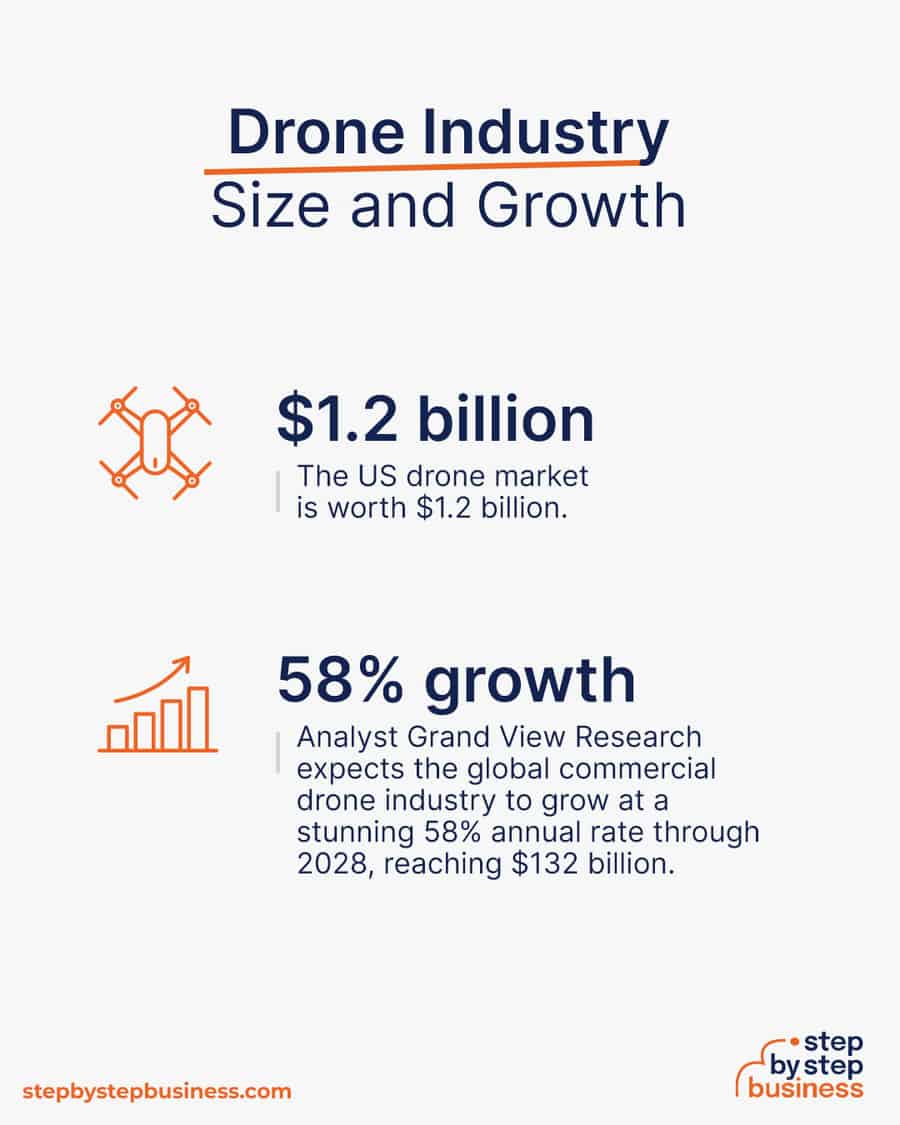
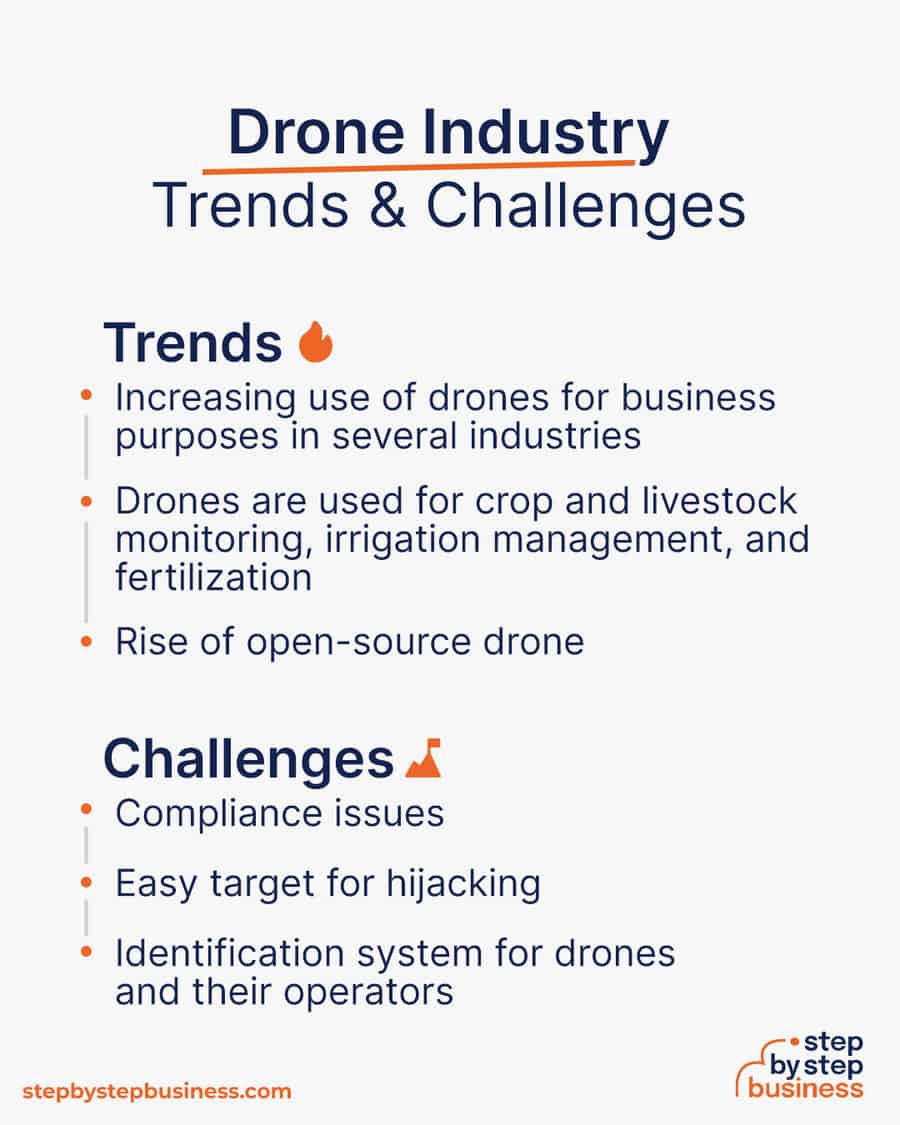
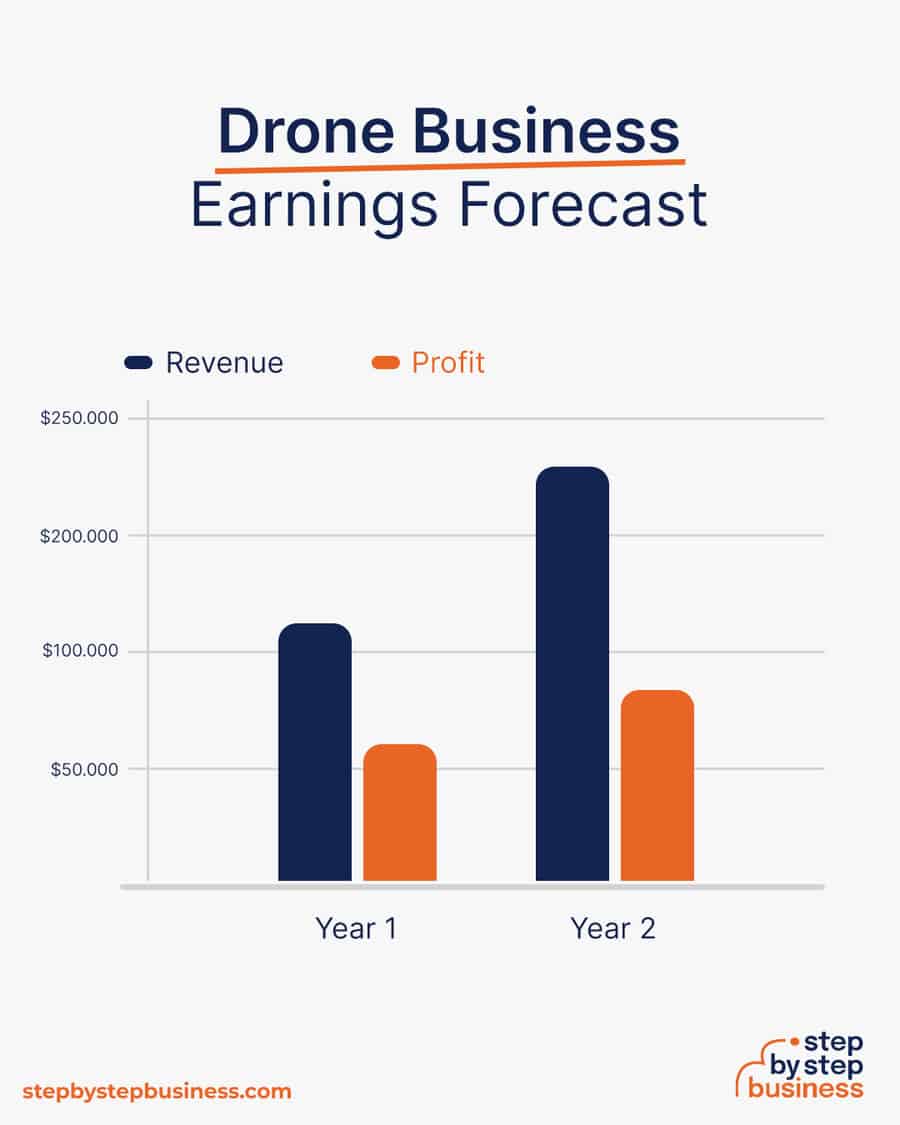
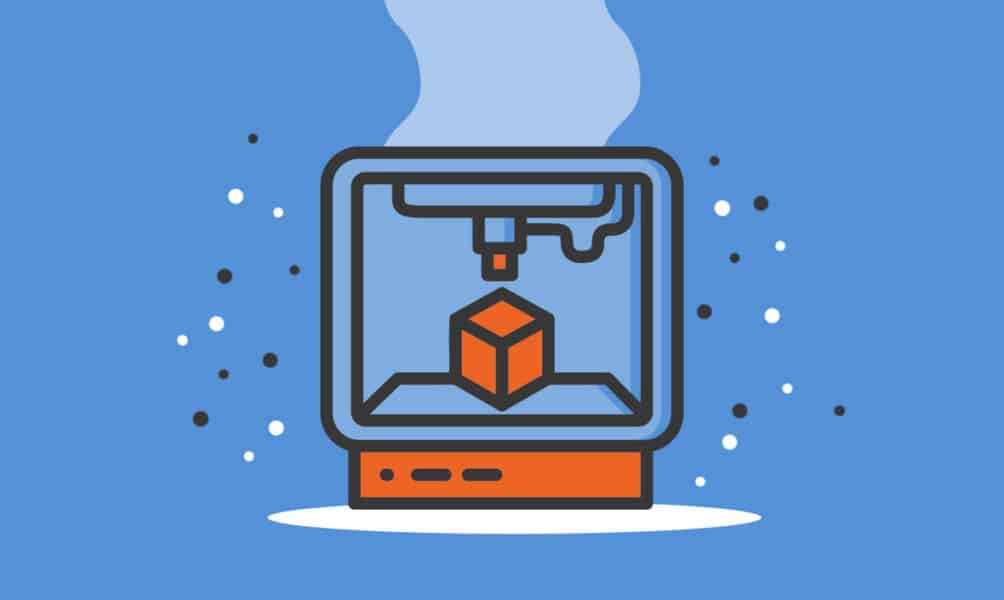



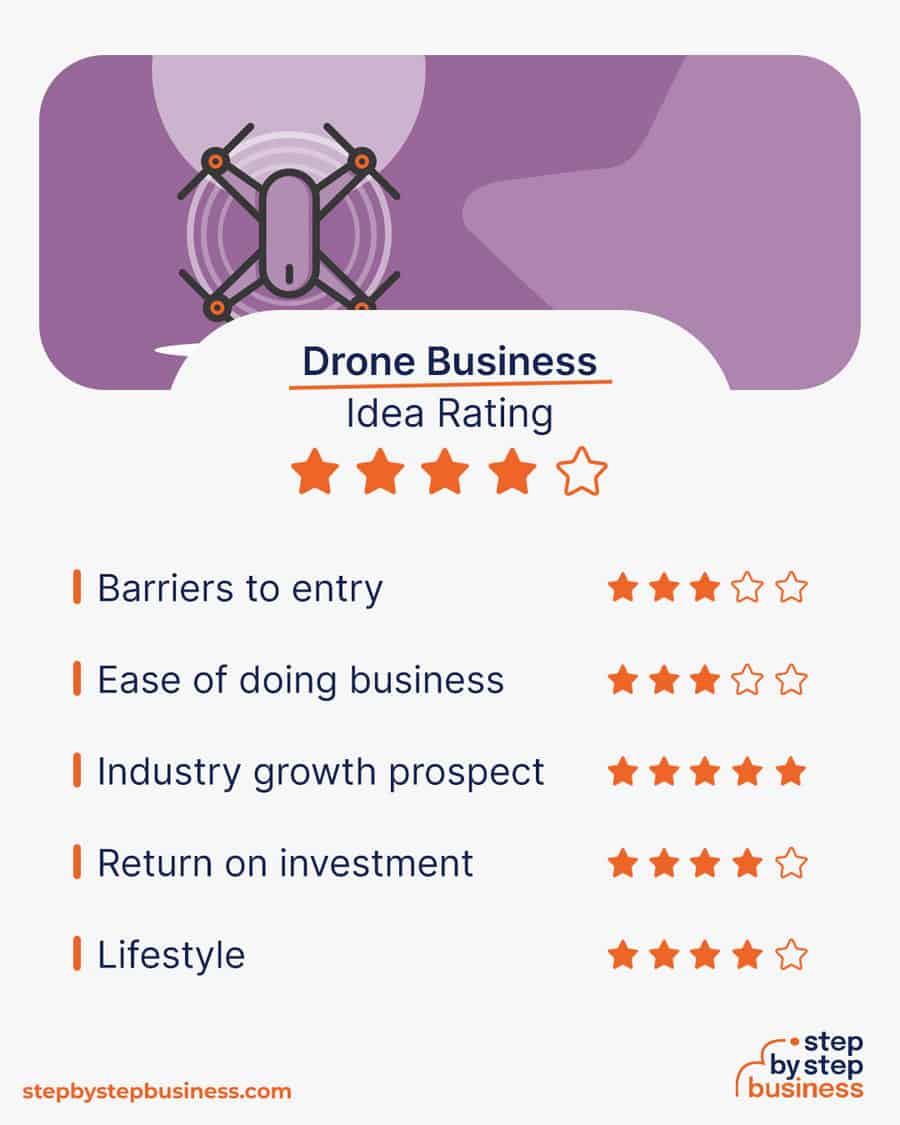













Comments